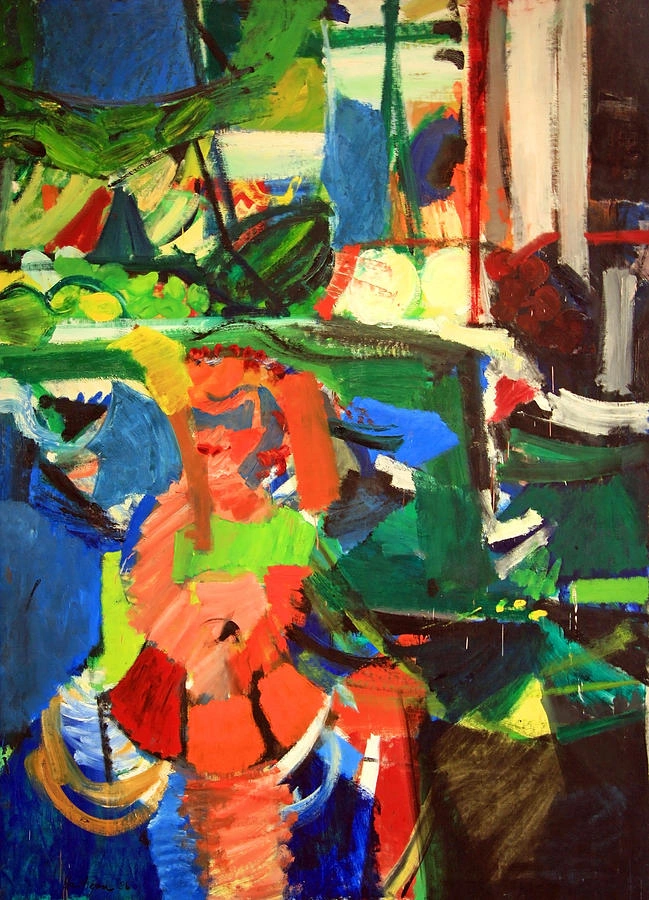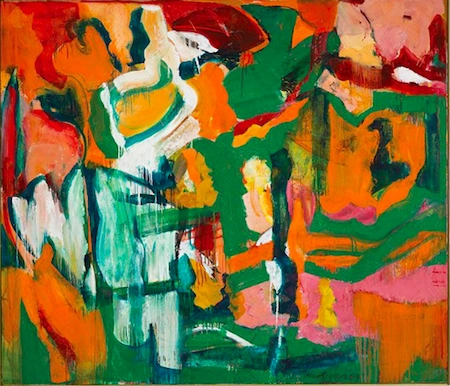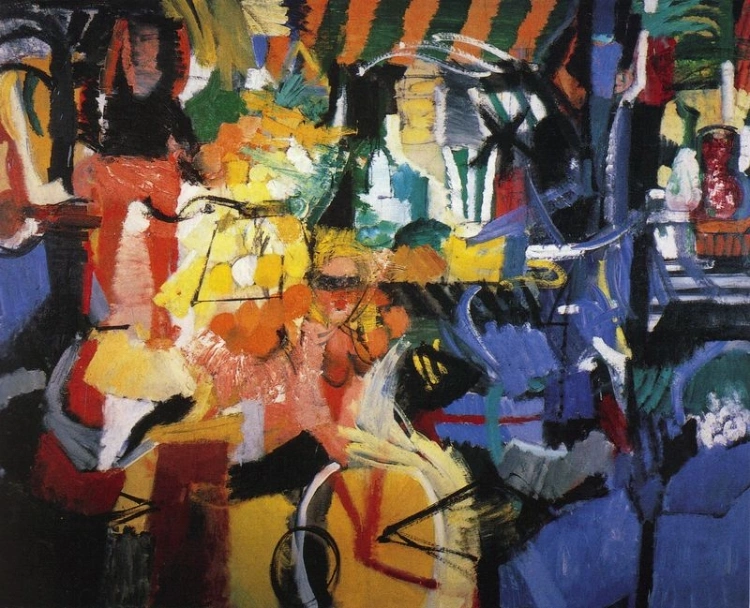Grace Hartigan – Fast Train
by David Fox
While Grace Hartigan started her art career later than many of her counterparts, her impact on the abstract expressionist genre was not diminished by this.
Hartigan was born and raised in Newark, New Jersey. Born in 1922, She was the eldest of four, which meant that she was not afforded the privilege of attending post-secondary, but she trained in mechanical drafting in the 1940s and studied with painter Isaac Lane Muse.

At 17, she married her first husband, who encouraged her to pursue art. She would divorce him in 1947 and get married three more times.
Hartigan moved to New York as she became serious about painting, and joined the likes of Franz Kline, Willem de Kooning, and Jackson Pollock. Pollock became a mentor to Hartigan, and by the late 50s, she was named “the most celebrated of the young American women painters” by Life magazine.
Hartigan lived to be 86, as she passed away in 2008 of liver failure. She left behind an incredible legacy of impressive artwork and being an iconic woman in the abstract expressionist genre.

“I cannot expect even my own art to provide all the answers – only to hope it keeps asking the right questions.”
Her Work
Grace Hartigan is known for her bold experimentation, gestural brush strokes, and emotional works. Her work suggests a sense of urgency.
Early works have an organic and curvilinear form, and older paintings have more distinct figures, symbols, and mythological references. The structures and figures in her work are emotional vehicles, and they’re painted in an expressionist manner.

In 1950, her career began when a painting of hers was selected for the “New Talent” show at the Kootz Gallery by Meyer Schapiro and Clement Greenberg. The show led to her first solo exhibition at the Tibor de Nagy Gallery.
In her career, these stepping stones pushed her to refine her style, as she felt she was lacking distinction and relied too heavily on Abstract Expressionism.
Goya, Velázquez, and other Old Master painters inspired her, along with Henri Matisse and Paul Cézanne.
Many of her peers did not approve of her new direction, but ‘The Persian Jacket,’ a painting she completed in 1952, became a permanent fixture in the Museum of Modern Art.

She used a Frank O’Hara poem to create a series of paintings in a collaborative effort with one of his friends.
“I don’t see how you can create and not have the feeling that it is the most important, all-consuming thing.”
Other established museums followed suit. The Whitney Museum bought the 1954 ‘Grand Street Brides,’ the Museum of Modern Art bought the 1953 ‘River Bathers,’ which was influenced by Matisse.
In 1956, she began working on the ‘City Life’ painting series, which features interlocking colour planes that reflect her neighbourhood’s streets.

Later that year, she would go on to be the only woman represented in the “Twelve Americans” exhibition at the Museum of Modern Art.
In 1958, ‘The New American Painting’ exhibition included her work, and she was the youngest artist and only woman to be included; and the exhibition travelled around Europe.
When she married her fourth husband, she moved to Baltimore in 1961. She initially regretted her move from the heart of the art scene in New York, so she tried to replicate her former studio in an abandoned factory.
Her 1957 work ‘Billboard’ was where she began to incorporate pop culture imagery into her work.

In the early 1960s, she was fascinated by Marilyn Monroe’s death and the Barbie doll launching into the mainstream. She drew upon these for her later works.
She began teaching at the Hoffberger School of Painting in 1964, becoming a part-time professor for the graduate program at the Maryland Institute College of Art.
She was known among students for her relentless critiques. The following year, she would become the director of the school, and she encouraged expressivity over everything else. She was becoming ill as she was a recovering alcoholic and suffered from osteoarthritis, but she refused to retire.
“Action/Precision: The New Direction in New York, 1955–60” and “The Figurative Fifties: New York Figurative Expressionism” were two major shows that exhibited her work in the 80s.
The last exhibition was titled “Hand-Painted Pop: American Art in Transition, 1955–62,” and it was held in LA, Chicago, and New York.
“I feel that we are living a very fragmented life, the whole world — you too. So I perceive the world in fragments. It is somewhat like being on a very fast train and getting glimpses of things in strange scales as you pass by.

A person can be very, very tiny. And a billboard can make a person very large. You see the corner of a house, or you see a bird fly by, and it’s all fragmented.
Somehow, in painting, I try to make some logic out of the world that has been given to me in chaos. I have a very pretentious idea that I want to make life, I want to make sense out of it. The fact that I am doomed to failure — that doesn’t deter me in the least.”
Her Legacy
Grace Hartigan was the recipient of numerous awards and honours over her lifetime. Six universities and colleges in Maryland and Pennsylvania chose Hartigan to be the recipient of honorary degrees.

She was also awarded the Lifetime Achievement Award from the Neuberger Museum in 2002 and the Governor’s Award in Baltimore, MA, in 2006.
Aside from her contributions to the American painting world, she was an incredible example of a fierce and independent female influence in art.
This era in art is often looked at by historians through a narrow and patriarchal lens, but she breaks through that lens. She was an extremely talented artist that demanded the attention away from her male counterparts.
She embraced the abstract expressionist movement while incorporating her own style, and it ensured her art remain relevant decades later, and it paved the way for future artists and the New Figuration and Neo-Expressionist movements.
Sources:
http://www.artnet.com/artists/grace-hartigan/
https://www.azquotes.com/author/23193-Grace_Hartigan
https://en.wikipedia.org/wiki/Grace_Hartigan
https://www.britannica.com/biography/Grace-Hartigan
Videos About Grace Hartigan

About David Fox
David Fox is an artist who created davidcharlesfox.com to talk about art and creativity. He loves to write, paint, and take pictures. David is also a big fan of spending time with his family and friends.
Leave a Reply
 |
 |
 |
 |
Now get FREE Gifts. Or latest Free phones here.
Disable Ad block to reveal all the secrets. Once done, hit a button below
 |
 |
 |
 |